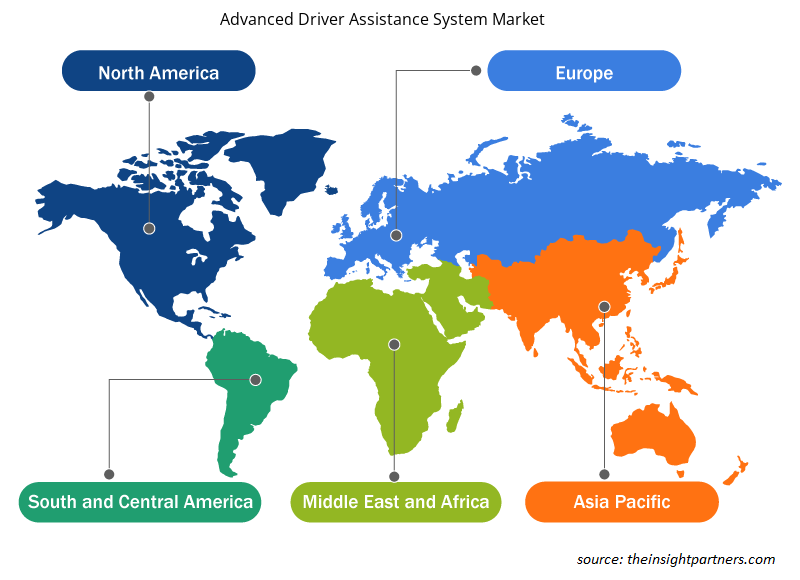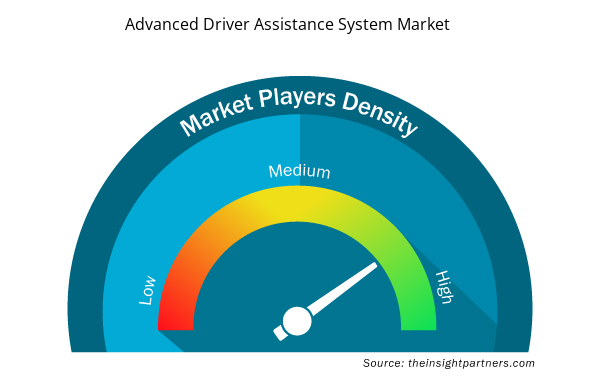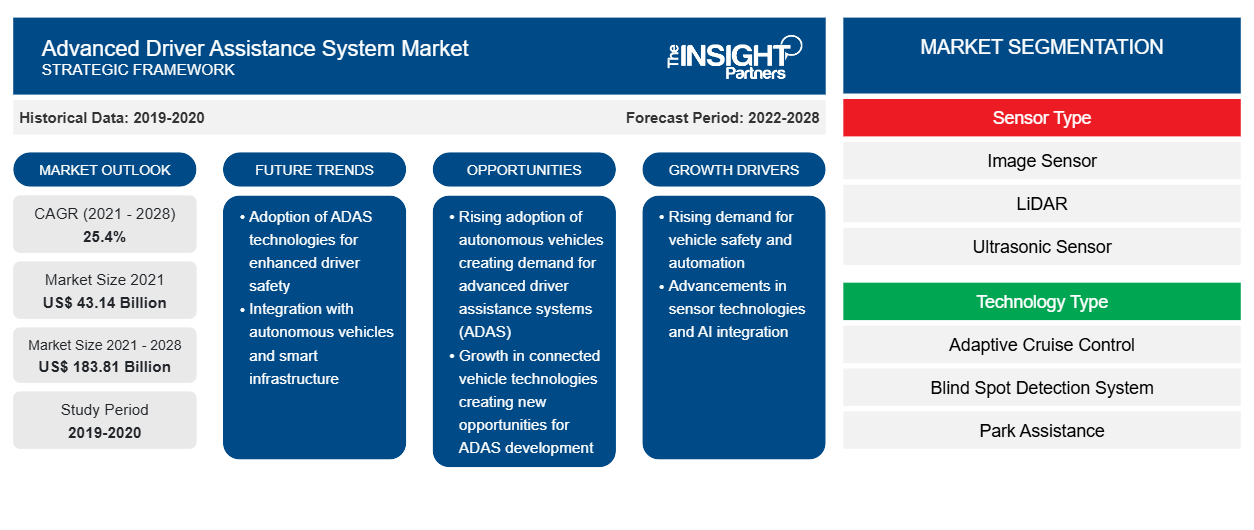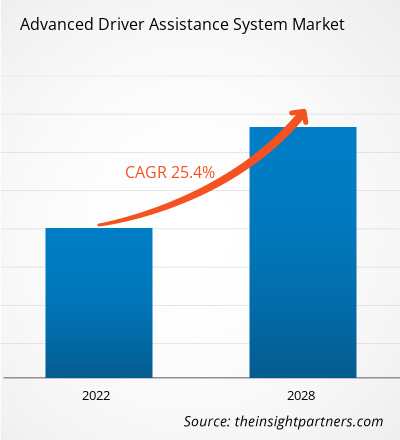[تقرير بحثي] من المتوقع أن ينمو سوق أنظمة مساعدة السائق المتقدمة (ADAS) من 43،138.44 مليون دولار أمريكي في عام 2021 إلى 183،814.84 مليون دولار أمريكي بحلول عام 2028؛ ومن المتوقع أن ينمو بمعدل نمو سنوي مركب قدره 25.4٪ من عام 2022 إلى عام 2028.
وجهة نظر المحلل:
شهد سوق أنظمة مساعدة السائق المتقدمة العالمية نموًا وتحولًا كبيرًا في السنوات الأخيرة، مدفوعًا بالتقدم التكنولوجي، وزيادة المخاوف المتعلقة بالسلامة، والسعي إلى تحسين تجارب القيادة. يشمل هذا القطاع الديناميكي من السوق مجموعة واسعة من التقنيات والميزات لمساعدة السائقين بطرق مختلفة، من تحسين السلامة إلى تعزيز الراحة والرفاهية.
يعد التركيز المتزايد على السلامة أحد المحركات الأساسية وراء نمو السوق. مع استمرار حوادث الطرق في تشكيل تهديد كبير للصحة والسلامة العامة، أصبحت أنظمة مساعدة السائق المتقدمة (ADAS) أمرًا بالغ الأهمية. اكتسبت ميزات مثل مساعدة الحفاظ على المسار، والتحكم التكيفي في ثبات السرعة ، والكبح التلقائي في حالات الطوارئ اعتمادًا واسع النطاق لأنها تساعد في تقليل مخاطر الحوادث الناجمة عن خطأ بشري. علاوة على ذلك، فإن انتشار أنظمة مساعدة السائق المتقدمة (ADAS) (ADAS) يغير كيفية تفاعل المستهلكين مع المركبات. تعتمد هذه الأنظمة على أجهزة الاستشعار والكاميرات وخوارزميات التعلم الآلي لإعطاء السائقين ملاحظات في الوقت الفعلي، مما يجعل التنقل أسهل. يتم دمج هذه التقنيات في كل من المركبات الفاخرة والمركبات متوسطة المدى والاقتصادية، مما يوسع نطاقها عبر مختلف شرائح المستهلكين.
مع استمرار تطور السوق، فإنها تواجه تحديات معينة. يمكن أن يؤدي تعقيد أنظمة مساعدة السائق المتقدمة إلى ارتفاع التكاليف، وهناك مخاوف بشأن موثوقيتها في جميع الظروف. علاوة على ذلك، أصبحت قضايا خصوصية البيانات والأمن السيبراني ذات أهمية متزايدة حيث تقوم هذه الأنظمة بجمع ومعالجة كميات هائلة من البيانات.
قم بتخصيص هذا التقرير ليناسب متطلباتك
ستحصل على تخصيص لأي تقرير - مجانًا - بما في ذلك أجزاء من هذا التقرير، أو تحليل على مستوى الدولة، وحزمة بيانات Excel، بالإضافة إلى الاستفادة من العروض والخصومات الرائعة للشركات الناشئة والجامعات
- احصل على أهم اتجاهات السوق الرئيسية لهذا التقرير.ستتضمن هذه العينة المجانية تحليلاً للبيانات، بدءًا من اتجاهات السوق وحتى التقديرات والتوقعات.
نظرة عامة على السوق:
لقد شهد سوق أنظمة مساعدة السائق المتقدمة نموًا كبيرًا على مدار السنوات الأخيرة، مدفوعًا بالطلب المتزايد باستمرار على ميزات الأمان المتقدمة وتجارب القيادة المحسنة. أنظمة مساعدة السائق المتقدمة (ADAS) هي مجموعة من الوظائف والتقنيات المصممة لمساعدة وتعزيز قدرات السائقين بطرق مختلفة، مما يساهم في النهاية في قيادة أكثر أمانًا وراحة.
الهدف الأساسي من أنظمة مساعدة السائق المتقدمة هو تحسين السلامة على الطرق من خلال تقليل احتمال وقوع الحوادث، وخاصة تلك الناجمة عن خطأ بشري. ويتم تحقيق ذلك من خلال مجموعة من أجهزة الاستشعار والكاميرات وتقنيات الرادار التي تراقب محيط السيارة باستمرار وتوفر ملاحظات في الوقت الفعلي للسائق. وتشمل بعض الميزات المشتركة لأنظمة مساعدة القيادة نظام تثبيت السرعة التكيفي، ومساعدة الحفاظ على المسار، والكبح التلقائي في حالات الطوارئ، ومراقبة النقاط العمياء. تعمل هذه الأنظمة معًا لمساعدة السائق في الحفاظ على مسافة آمنة بين السيارات، والبقاء داخل المسار، وتجنب الاصطدامات.
إن عمل هذه الأنظمة يتمحور حول جمع البيانات ومعالجتها وتشغيلها. حيث تقوم أجهزة استشعار وكاميرات مختلفة حول السيارة بجمع البيانات حول حالة الطريق والأشياء القريبة وحالة السيارة. ثم تتم معالجة هذه البيانات بواسطة أنظمة الكمبيوتر الموجودة على متن السيارة، والتي تستخدم خوارزميات متطورة لتفسيرها واتخاذ القرارات. على سبيل المثال، يستخدم نظام تثبيت السرعة التكيفي الرادار لقياس المسافة إلى السيارة التي أمام السيارة، وضبط السرعة للحفاظ على مسافة آمنة. وبالمثل، يستخدم نظام مساعدة الحفاظ على المسار الكاميرات للكشف عن علامات المسار وتوجيه السيارة برفق لإبقائها داخل المسار إذا بدأ السائق في الانحراف.
مع تقدم التكنولوجيا، تتوسع قدرات أنظمة مساعدة السائق المتقدمة (ADAS)، وتصبح جزءًا لا يتجزأ من المركبات الحديثة بشكل متزايد. وفي حين تعمل هذه الأنظمة بلا شك على تعزيز السلامة وراحة السائق، إلا أن هناك تحديات لا تزال بحاجة إلى معالجتها، بما في ذلك تكلفة التنفيذ وموثوقية النظام ومخاوف الأمن السيبراني.
محرك السوق:
زيادة الطلب على السلامة لتعزيز نمو سوق أنظمة مساعدة السائق المتقدمة
إن سوق أنظمة مساعدة السائق المتقدمة العالمية في مسار تصاعدي، مدفوعًا إلى حد كبير بالتركيز التنظيمي المتزايد على السلامة على الطرق. لقد أدركت الحكومات في جميع أنحاء العالم الدور الحاسم الذي تلعبه أنظمة مساعدة السائق المتقدمة في الحد من الحوادث وإنقاذ الأرواح. تسلط الإحصائيات التي قدمتها وكالات حكومية مختلفة الضوء على أهمية وضع السلامة على الطرق والحاجة إلى تقنيات السلامة المتقدمة. في الولايات المتحدة، أفادت الإدارة الوطنية لسلامة المرور على الطرق السريعة (NHTSA) أنه في عام 2021 كان هناك 42939 حالة وفاة بسبب حوادث السيارات. تسلط هذه الأرقام الضوء على الحاجة الملحة إلى حلول مبتكرة للتخفيف من الخطأ البشري الذي يساهم غالبًا في حوادث الطرق. ونتيجة لذلك، تعمل الهيئات الحكومية في الولايات المتحدة والعديد من البلدان الأخرى على تكثيف جهودها لإلزام وتشجيع دمج أنظمة مساعدة السائق المتقدمة (ADAS) في المركبات الجديدة. على سبيل المثال، في عام 2022، جعل الاتحاد الأوروبي بعض ميزات مساعدة السائق المتقدمة الأساسية إلزامية في سيارات الركاب والمركبات. يعد هذا الدفع التنظيمي، إلى جانب الوعي العام المتزايد والطلب على المركبات الأكثر أمانًا، محركًا رئيسيًا في نمو سوق أنظمة مساعدة السائق المتقدمة العالمية. ويتماشى مستقبل صناعة السيارات مع تطوير ودمج أنظمة السلامة المتقدمة هذه مع استمرارها في تقليل العبء الاقتصادي المرتبط بحوادث الطرق.
التحليل القطاعي:
بناءً على نوع السيارة، يتم تقسيم السوق إلى سيارات ركاب ومركبات تجارية . ومن بين هذه السيارات، تشهد سيارات الركاب نموًا سريعًا، مع ارتفاع الطلب على إنتاج المركبات الفاخرة المتميزة في جميع أنحاء العالم. كما أن ارتفاع مبيعات المركبات مع ارتفاع الدخل المتاح للأشخاص في دول مثل الولايات المتحدة والهند يدفع نمو السوق. شهدت مبيعات سيارات الركاب في الهند نموًا سنويًا بنحو 25٪ عن العام السابق لتصل إلى 3.8 مليون في عام 2022. علاوة على ذلك، فإن التبني المتزايد للسيارات الكهربائية في الصين هو عامل آخر يدعم نمو السوق. وفقًا لجمعية مصنعي السيارات الصينية، شهدت مبيعات السيارات الكهربائية في الصين نموًا بنسبة 93.4٪ مقارنة بعام 2021.
التحليل الإقليمي:
يشهد سوق أنظمة مساعدة السائق المتقدمة (ADAS) في منطقة آسيا والمحيط الهادئ نموًا مستمرًا، وتساهم العديد من العوامل في هذا التوسع الملحوظ.
إن أحد الأسباب الرئيسية للنمو المتسارع لسوق أنظمة مساعدة السائق المتقدمة في منطقة آسيا والمحيط الهادئ هو الموقف الاستباقي الذي اتخذته الحكومات في المنطقة. حيث تدرك الحكومات بشكل متزايد الدور الحاسم الذي تلعبه أنظمة مساعدة السائق المتقدمة في تعزيز السلامة على الطرق وتخفيف التحديات المرورية الشديدة الناجمة عن التوسع الحضري السريع والنمو السكاني في العديد من البلدان. على سبيل المثال، في اليابان، حيث سجل السلامة على الطرق قوي نسبيًا، لا تزال الحكومة استباقية في الترويج لنظام مساعدة السائق المتقدم. وقد دعمت وكالة الشرطة الوطنية اليابانية تطوير وتنفيذ هذه الأنظمة. كما أطلقت اليابان مبادرات مثل "خريطة طريق السيارات المتصلة" لتشجيع تبني التقنيات المتقدمة، بما في ذلك نظام مساعدة السائق المتقدم، لتعزيز السلامة والحد من حوادث المرور. وقد أدى هذا إلى زيادة مطردة في المركبات المجهزة بنظام مساعدة السائق المتقدم في السوق اليابانية.
علاوة على ذلك، فإن صناعة السيارات التي تشهد نموًا مستمرًا في منطقة آسيا والمحيط الهادئ تشكل عاملًا آخر يدفع نمو السوق. وتعد قاعدة المستهلكين القوية، والدخل المتاح المتزايد، والاعتماد المتزايد على المركبات الكهربائية من العوامل التي تدعم نمو نظام مساعدة السائق المتقدم في المنطقة.
تحليل اللاعب الرئيسي:
يتكون تحليل سوق نظام مساعدة السائق المتقدم من لاعبين مثل Continental AG وZF Friedrichshafen وAptiv PLC وValeo وHella Kgaa Hueck & Co. وRobert Bosch Gmbh وHyundai Mobis وMagna International وAutoliv وDenso Corporation. في عام 2023، دخلت شركة بورش في شراكة مع شركة Mobiley لتوفير نظام مساعدة سائق متقدم من المستوى 2+.
نظام مساعدة السائق المتقدم (ADAS)
رؤى إقليمية حول سوق أنظمة مساعدة السائق المتقدمة
لقد قام المحللون في Insight Partners بشرح الاتجاهات والعوامل الإقليمية المؤثرة على سوق نظام مساعدة السائق المتقدم طوال فترة التوقعات بشكل شامل. يناقش هذا القسم أيضًا قطاعات سوق نظام مساعدة السائق المتقدم والجغرافيا في جميع أنحاء أمريكا الشمالية وأوروبا ومنطقة آسيا والمحيط الهادئ والشرق الأوسط وأفريقيا وأمريكا الجنوبية والوسطى.

- احصل على البيانات الإقليمية المحددة لسوق أنظمة مساعدة السائق المتقدمة
نطاق تقرير سوق أنظمة مساعدة السائق المتقدمة
| سمة التقرير | تفاصيل |
|---|---|
| حجم السوق في عام 2021 | 43.14 مليار دولار أمريكي |
| حجم السوق بحلول عام 2028 | 183.81 مليار دولار أمريكي |
| معدل النمو السنوي المركب العالمي (2021 - 2028) | 25.4% |
| البيانات التاريخية | 2019-2020 |
| فترة التنبؤ | 2022-2028 |
| القطاعات المغطاة | حسب نوع المستشعر
|
| المناطق والدول المغطاة | أمريكا الشمالية
|
| قادة السوق وملفات تعريف الشركات الرئيسية |
|
كثافة اللاعبين في سوق أنظمة مساعدة السائق المتقدمة: فهم تأثيرها على ديناميكيات الأعمال
يشهد سوق أنظمة مساعدة السائق المتقدمة نموًا سريعًا، مدفوعًا بالطلب المتزايد من المستخدم النهائي بسبب عوامل مثل تفضيلات المستهلكين المتطورة والتقدم التكنولوجي والوعي المتزايد بفوائد المنتج. ومع ارتفاع الطلب، تعمل الشركات على توسيع عروضها والابتكار لتلبية احتياجات المستهلكين والاستفادة من الاتجاهات الناشئة، مما يؤدي إلى زيادة نمو السوق.
تشير كثافة اللاعبين في السوق إلى توزيع الشركات أو المؤسسات العاملة في سوق أو صناعة معينة. وهي تشير إلى عدد المنافسين (اللاعبين في السوق) الموجودين في مساحة سوق معينة نسبة إلى حجمها أو قيمتها السوقية الإجمالية.
الشركات الرئيسية العاملة في سوق نظام مساعدة السائق المتقدم هي:
- شركة كونتيننتال ايه جي
- شركة سيبرس لأشباه الموصلات
- شركة First Sensor AG (TE Connectivity)
- هارمان العالمية (مجموعة سامسونج)
- شركة هيتاشي المحدودة
إخلاء المسؤولية : الشركات المذكورة أعلاه ليست مرتبة بأي ترتيب معين.

- احصل على نظرة عامة على أهم اللاعبين الرئيسيين في سوق أنظمة مساعدة السائق المتقدمة
التطورات الأخيرة:
تتبنى الشركات العديد من الاستراتيجيات، مثل التعاون والشراكات والاندماجات والاستحواذات وتطوير منتجات جديدة في سوق أنظمة مساعدة السائق المتقدمة العالمية. وفيما يلي بعض التطورات الرئيسية الأخيرة في السوق:
- في عام 2023، دخلت شركتا Continental وAmbarella في شراكة لتطوير حلول متكاملة للأجهزة والبرامج تعتمد على الذكاء الاصطناعي.
- في عام 2023، أطلقت جنرال موتورز تقنية مساعدة السائق Ultra Cruise. تراقب Ultra Cruise وضع رأس السائق وعينيه المنسقتين مع الطريق باستخدام مجموعة من الكاميرات والرادارات قصيرة وطويلة المدى، وLiDAR خلف الزجاج الأمامي، ونظام معالجة جديد تمامًا، ونظام انتباه السائق.
- التحليل التاريخي (سنتان)، السنة الأساسية، التوقعات (7 سنوات) مع معدل النمو السنوي المركب
- تحليل PEST و SWOT
- حجم السوق والقيمة / الحجم - عالميًا وإقليميًا وقطريًا
- الصناعة والمنافسة
- مجموعة بيانات Excel



Report Coverage
Revenue forecast, Company Analysis, Industry landscape, Growth factors, and Trends

Segment Covered
This text is related
to segments covered.

Regional Scope
North America, Europe, Asia Pacific, Middle East & Africa, South & Central America

Country Scope
This text is related
to country scope.
الأسئلة الشائعة
Asia Pacific dominated The Advanced driver assistance systems (ADAS) market in 2021 with a share of 46.1%; it would continue to dominate the market during the forecast period and account for 50.2% share by 2028
The driving factors impacting the Advanced driver assistance systems (ADAS) market are
I. Growing Demand for Safety and Driving Comfort Features
II. Rising Adoption of Integrated Radar and Camera Systems
The global advanced driver assistance systems (ADAS) market was valued at US$ 43,138.44 million in 2021
The global advanced driver assistance systems (ADAS) market size is projected to reach US$ 183,814.84 million by 2028.
The blind-spot detection segment led the advanced driver assistance systems (ADAS) market in 2021.
The key players holding the major market share of the advanced driver assistance systems (ADAS) market are Continental AG; Hitachi, ltd; Denso Corporation; Harman International; and NXP semiconductors.
The Future trends impacting the advanced driver assistance systems (ADAS) market are - Growing Demand for Embedded Vision Systems in Vehicles
APAC is the fastest-growing regional market in the global Advanced driver assistance systems (ADAS) market in 2021.
The List of Companies - Advanced Driver Assistance Systems (ADAS) Market
- Continental AG
- Cypress Semiconductor Corporation
- First Sensor AG (TE Connectivity)
- Harman International (Samsung Group)
- Hitachi, Ltd.
- MG Motor India Private Limited
- NVIDIA Corporation
- Robert Bosch GmbH
- Telefonaktiebolaget LM Ericsson
- Vector Informatik GmbH
The Insight Partners performs research in 4 major stages: Data Collection & Secondary Research, Primary Research, Data Analysis and Data Triangulation & Final Review.
- Data Collection and Secondary Research:
As a market research and consulting firm operating from a decade, we have published and advised several client across the globe. First step for any study will start with an assessment of currently available data and insights from existing reports. Further, historical and current market information is collected from Investor Presentations, Annual Reports, SEC Filings, etc., and other information related to company’s performance and market positioning are gathered from Paid Databases (Factiva, Hoovers, and Reuters) and various other publications available in public domain.
Several associations trade associates, technical forums, institutes, societies and organization are accessed to gain technical as well as market related insights through their publications such as research papers, blogs and press releases related to the studies are referred to get cues about the market. Further, white papers, journals, magazines, and other news articles published in last 3 years are scrutinized and analyzed to understand the current market trends.
- Primary Research:
The primarily interview analysis comprise of data obtained from industry participants interview and answers to survey questions gathered by in-house primary team.
For primary research, interviews are conducted with industry experts/CEOs/Marketing Managers/VPs/Subject Matter Experts from both demand and supply side to get a 360-degree view of the market. The primary team conducts several interviews based on the complexity of the markets to understand the various market trends and dynamics which makes research more credible and precise.
A typical research interview fulfils the following functions:
- Provides first-hand information on the market size, market trends, growth trends, competitive landscape, and outlook
- Validates and strengthens in-house secondary research findings
- Develops the analysis team’s expertise and market understanding
Primary research involves email interactions and telephone interviews for each market, category, segment, and sub-segment across geographies. The participants who typically take part in such a process include, but are not limited to:
- Industry participants: VPs, business development managers, market intelligence managers and national sales managers
- Outside experts: Valuation experts, research analysts and key opinion leaders specializing in the electronics and semiconductor industry.
Below is the breakup of our primary respondents by company, designation, and region:

Once we receive the confirmation from primary research sources or primary respondents, we finalize the base year market estimation and forecast the data as per the macroeconomic and microeconomic factors assessed during data collection.
- Data Analysis:
Once data is validated through both secondary as well as primary respondents, we finalize the market estimations by hypothesis formulation and factor analysis at regional and country level.
- Macro-Economic Factor Analysis:
We analyse macroeconomic indicators such the gross domestic product (GDP), increase in the demand for goods and services across industries, technological advancement, regional economic growth, governmental policies, the influence of COVID-19, PEST analysis, and other aspects. This analysis aids in setting benchmarks for various nations/regions and approximating market splits. Additionally, the general trend of the aforementioned components aid in determining the market's development possibilities.
- Country Level Data:
Various factors that are especially aligned to the country are taken into account to determine the market size for a certain area and country, including the presence of vendors, such as headquarters and offices, the country's GDP, demand patterns, and industry growth. To comprehend the market dynamics for the nation, a number of growth variables, inhibitors, application areas, and current market trends are researched. The aforementioned elements aid in determining the country's overall market's growth potential.
- Company Profile:
The “Table of Contents” is formulated by listing and analyzing more than 25 - 30 companies operating in the market ecosystem across geographies. However, we profile only 10 companies as a standard practice in our syndicate reports. These 10 companies comprise leading, emerging, and regional players. Nonetheless, our analysis is not restricted to the 10 listed companies, we also analyze other companies present in the market to develop a holistic view and understand the prevailing trends. The “Company Profiles” section in the report covers key facts, business description, products & services, financial information, SWOT analysis, and key developments. The financial information presented is extracted from the annual reports and official documents of the publicly listed companies. Upon collecting the information for the sections of respective companies, we verify them via various primary sources and then compile the data in respective company profiles. The company level information helps us in deriving the base number as well as in forecasting the market size.
- Developing Base Number:
Aggregation of sales statistics (2020-2022) and macro-economic factor, and other secondary and primary research insights are utilized to arrive at base number and related market shares for 2022. The data gaps are identified in this step and relevant market data is analyzed, collected from paid primary interviews or databases. On finalizing the base year market size, forecasts are developed on the basis of macro-economic, industry and market growth factors and company level analysis.
- Data Triangulation and Final Review:
The market findings and base year market size calculations are validated from supply as well as demand side. Demand side validations are based on macro-economic factor analysis and benchmarks for respective regions and countries. In case of supply side validations, revenues of major companies are estimated (in case not available) based on industry benchmark, approximate number of employees, product portfolio, and primary interviews revenues are gathered. Further revenue from target product/service segment is assessed to avoid overshooting of market statistics. In case of heavy deviations between supply and demand side values, all thes steps are repeated to achieve synchronization.
We follow an iterative model, wherein we share our research findings with Subject Matter Experts (SME’s) and Key Opinion Leaders (KOLs) until consensus view of the market is not formulated – this model negates any drastic deviation in the opinions of experts. Only validated and universally acceptable research findings are quoted in our reports.
We have important check points that we use to validate our research findings – which we call – data triangulation, where we validate the information, we generate from secondary sources with primary interviews and then we re-validate with our internal data bases and Subject matter experts. This comprehensive model enables us to deliver high quality, reliable data in shortest possible time.


 احصل على عينة مجانية لهذا التقرير
احصل على عينة مجانية لهذا التقرير